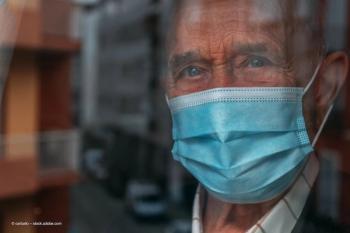
- Ophthalmology Times Europe July/August 2025
- Volume 21
- Issue 4
- Pages: 8 - 11
Feasibility of artificial intelligence in leading glaucoma care
Can AI compete with the well-oiled machine of the contemporary clinic?
A topic in the spotlight recently is the impact of artificial intelligence (AI) on medical care. While the technology is still in its infancy and is evolving at a fantastic pace, physicians are divided on its appropriate place in patient care.
Two experts stated their views during a debate on the role of physicians and AI in the diagnosis and management of glaucoma at the 16th Annual Congress on Controversies in Ophthalmology in Seville, Spain.
Professor M. Francesca Cordeiro, PhD, MD, MRCP, FRCOphth, stood on the side of physician expertise for glaucoma management, and Professor Marta Pazos, MD, PhD, took a stance for AI.
Dr Cordeiro is Chair of Ophthalmology at Imperial College London; UCL Professor of Glaucoma and Retinal Neurodegeneration Studies; Consultant Ophthalmologist and Research Lead, Western Eye Hospital; and Director of the Imperial College Ophthalmology Research Group, Imperial Clinical Trials Unit, London. Marta Pazos, MD, PhD, is a glaucoma consultant and head of the surgery section, Institut Clínic d’Oftalmologia Hospital Clínic Barcelona, research investigator at the Institut d’Investigacions Biomèdiques August Pi i Sunyer (IDIBAPS), and associate professor at the Universitat de Barcelona, Barcelona, Spain.
The pro-physician platform
Dr Cordeiro believes that the human element is lacking in AI.
To defend the human advantage, she expressed the importance of the holistic approach by which clinicians consider the overall patient health and lifestyle and their preferences. Physician management of glaucoma facilitates collaborative decision making by which they can engage patients in treatment discussion, thereby improving patient adherence. Finally, in the management of complex cases, clinicians excel in the explanation of atypical presentation and comorbidities.
In contrast, she cited the current AI limitations in the diagnosis of glaucoma. These included limited training data; AI only knows the data it was trained on, which does not facilitate comprehensive management. Second, AI struggles with rare cases as atypical presentation confuses algorithmic approaches. Third, AI may perform poorly on underrepresented patient groups.
She stated, “These limitations make AI unreliable for independent clinical decision making in many real-world scenarios.” A strong argument for Dr Cordeiro rests on the complexity of glaucoma management. Intraocular pressure (IOP) targets vary based on patient factors, the choice of IOP drugs are affected by patient comorbidities, immediate treatment needs must be balanced with long-term management and patient compliance represents a real-world challenge.
Clinical decision-making is an art
Management decisions depend on factors that remain in flux, Dr Cordeiro explained, with the changing clinical landscape. She pointed out that clinical decisions combine objective measurements with subjective assessment, for which human clinicians excel.
Effective glaucoma treatment requires an understanding of patient concerns; physicians can adapt their explanations to individual levels of understanding.
In addition, experienced physicians incorporate the latest results from research into their practice based on clinical judgment.
The human touch
Patients prefer interactions regarding diagnoses and treatment questions, which is beyond the capacity of AI. This interaction builds trust and improves compliance with treatment. When errors in management occur, patients can turn to a responsible party.
AI as a tool
Dr Cordeiro views the current role of AI in practice as a tool that can enhance, but not replace, the clinical decision-making process.
“AI excels at rapid processing of large datasets.However, clinicians provide the clinical interpretation and give context to the raw data. Human judgment then can apply the research findings to individual patients. The optimal approach combines AI’s computational power with human clinical wisdom,” she stated. AI offers advantages that were previously unavailable: enhanced screening to identify high-risk patients, diagnostic accuracy of glaucomatous patterns and predictive analytics for disease progression.
The path forward
Dr Cordeiro invites a synergistic approach in practice that combines the use of AI with human expertise. AI should continuously improve over time and learn from clinical feedback, and clinicians should adapt to new technologies.
“Technology should enhance, not diminish, the doctor-patient relationship. The goal remains optimal patient outcomes,” she stated.
“AI tools should augment clinical judgment, not be a substitute for it," she continued. "Physicians provide crucial context to algorithmic output. The future is human-centred. The best glaucoma care will always require expertise. Clinicians remain the cornerstone of effective glaucoma management."
The pro-AI platform
Dr Pazos cited five reasons to use AI in glaucoma care: excellent diagnostic accuracy, optimised referrals, cost-effective screening, estimations of glaucoma progression and earlier ability to predict patients at high risk of progression and those requiring surgery. She cited a meta-analysis1 that evaluated the performance of machine learning for detecting glaucoma using fundus and retinal optical coherence tomography (OCT) images. The study found that the performance of machine learning for detecting glaucoma compared favourably to the expertise of clinicians.
In fact, another study2 found that AI can outperform glaucoma specialists in diagnostic and treatment accuracy. The investigators concluded that the “study accentuates the comparative proficiency of large language model chatbots in diagnostic accuracy and completeness compared with fellowship-trained ophthalmologists in various clinical scenarios. The large language model chatbot outperformed glaucoma specialists and matched retina specialists in diagnostic and treatment accuracy, substantiating its role as a promising diagnostic adjunct in ophthalmology.”
Referral optimisation
Data provided by Luis Abegao-Pinto, MD, head of the Glaucoma Clinic of the Department of Ophthalmology of Hospital Santa Maria and Assistant Professor of Ophthalmology, Faculty of Medicine, Lisbon University, showed that of 198 study eyes, 70 underwent an in-person examination in the glaucoma department and 33 were diagnosed with glaucoma.
The results showed a relatively high rate of referral without a confirmed glaucoma diagnosis. This can be common in glaucoma screening and referral processes, with some studies reporting false positive referral rates between 29% and 68%. In contrast, AI screening would have prevented almost two-thirds of the referrals.
AI makes referrals from home feasible. Investigators found that an AI system using a smartphone-based fundus camera showed a sensitivity and specificity of 93.7% (95% CI: 87.6–96.9%) and 85.6% (95% CI: 78.6–90.6%), respectively, in the detection of referable glaucoma when compared against final diagnosis following a full glaucoma workup. When compared to the detection results of image readers, the specialists detected 60% of true glaucoma cases versus a detection rate of 94% by AI,3 Dr Pazos reported.
Screening cost-effectiveness
Glaucoma remains one of the foremost causes of irreversible blindness globally. Although it fulfils several World Health Organization criteria for being a screenable disease, population-wide screening has not been widely adopted, largely due to concerns about cost-effectiveness. However, AI is emerging as a transformative tool that could make glaucoma screening both scalable and economically viable.
The Portugal Screening Trial and its Spanish equivalent, the Barcelona Esquerra Glaucoma Artificial Intelligence-based Screening program (BEGAS), are currently evaluating the cost-effectiveness of AI screening using retinographies. The preliminary Portuguese data of the first 671 patients screened showed that 82 (12%) met referral criteria, and 72 (11%) underwent clinic evaluation. Of these, 34 satisfied the glaucoma criteria (5.1% prevalence) using definitions 1 and 2, which were respectively defined as the presence of both visual field and optic disc changes and the presence of only one of those factors. Eighteen patients satisfied (2.4% prevalence) the criteria with definition 1 alone. Eight patients already had moderate or worse disease at diagnosis.
In this optimised glaucoma screening system, one patient is diagnosed with glaucoma for every 20 screened subjects and one patient with moderate-to-advanced glaucoma are diagnosed for every 84 patients screened. The cost was 430 euros to detect one glaucoma case and 940 euros to detect moderate or advanced disease. The Markov model suggested that 148 subjects need to be screened to prevent one case of blindness at 10 years, and the system was found to be cost-effective when the costs of visual impairment exceeded 10,000 euros. These results need to be validated, but show promise to make glaucoma screening more cost-effective, Dr Pazos reported.
Estimating glaucoma progression
Recent studies4-7 have garnered the following conclusions:
- Different deep learning models accurately detected progression from visual field data.
- An unsupervised model identified visual field worsening patterns associated with rapid progression in the Ocular Hypertension Treatment Study dataset.A model trained with visual field data predicted future progression in glaucoma patients from colour fundus photographs.
- A convolutional neural network model accurately identified glaucoma progression from longitudinal OCT data.
Predicting patients at higher risk
The ability to predict patients at higher risk of disease progression will facilitate customised management of glaucoma. Dr Pazos cited a study8 in which the investigators developed a multimodal deep learning model that included a convolutional neural network and a long short-term memory network to predict glaucoma progression. They analysed OCT images, visual field values, and the demographic and clinical data from 86 glaucoma patients who had been evaluated during five visits over a 12-month period.
They wanted to predict VF changes 12 months after the first visit by combining past multimodal inputs with synthesised future images generated using a generative adversarial network. The patients were classified based on the decreases in their visual field mean deviation (MD), ie, slow progressors were defined as having declines under three decibels and fast progressors as those progressing more than three decibels.
The authors reported, “The generative model-based novel approach achieved the best area under the curve (AUC) of 0.83 for predicting the progression 6 months earlier. The use of synthetic future images enabled the model to accurately predict the vision loss 9 months earlier with an AUC of 0.81, compared to using only structural (AUC = 0.68) or only functional measures (AUC = 0.72). This study provides valuable insights into the potential of using synthetic follow-up OCT images for early detection of glaucoma progression.”
Another study9 that aimed to determine if AI could predict which patients would progress to the point of needing surgery reported that machine learning models developed using only structured electronic health records data can reasonably predict whether glaucoma patients will need surgery.
Why is AI still not implemented in the clinic?
While investigations into the use of AI have yielded positive data, the remaining challenges include10:
- AI algorithms are often built and validated in a small number of centres with very specific instruments, and, therefore, may not be representative.
- The available data are heterogeneous, and there is a lack of structured and publicly available databases (variability in quality can affect algorithm performance).
- Ground truth quality in glaucoma is difficult to assess.
- The cost of using visual field data is greater than with other strategies, therefore they are less represented.
- There is a huge diversity of health systems worldwide.
The main barrier for clinical implementation is a problem of trust, Dr Pazos explained. AI has potential risks, legal and ethical implications. Many stakeholders perceive AI algorithms as opaque and difficult to understand.
The Future
To address current limitations, several strategies can enhance the trustworthiness of AI11:
- Improving data quality: Since AI systems can amplify existing biases, the use of high-quality, diverse, and representative datasets is essential.
- Data ownership strategies: Approaches such as federated learning allow algorithms to be trained across decentralised data sources without transferring sensitive data, thus preserving privacy.
- Explainability: Techniques like saliency maps and heat maps help visualise which parts of the input the AI model focuses on, aiding interpretation and fostering user trust.
- Generalisability: Validating AI models across diverse populations and incorporating synthetic data can improve robustness and ensure broader applicability.
Dr Pazos concluded, “AI holds significant promise in advancing glaucoma care. Key opportunities include automating diagnosis and screening, particularly valuable in underserved or rural settings via telemedicine and referral systems; supporting clinical decision-making through visual aids for clinicians; and, most importantly, enabling predictive analytics. These predictive tools can drive personalised care by supporting ocular phenotyping, risk assessment, treatment planning, and early detection of high-risk patients.”
References
Wu J-H, Nishida T, Weinreb RN, Lin J-W. Performances of machine learning in detecting glaucoma using fundus and retinal optical coherence tomography images: a meta-analysis. Am J Ophthalmol. 2022;237:1-12.
Huang AS, Hirabayashi K, Barna L, Parikh D, Pasquale LR. Assessment of a large language model’s responses to questions and cases about glaucoma and retina management. JAMA Ophthalmol. 2024;142::371-375. doi: 10.1001/jamaophthalmol.2023.6917.
Rao DP, Shroff S, Savoy FM, et al. Evaluation of an offline, artificial intelligence system for referable glaucoma screening using a smartphone-based fundus camera: a prospective study. Eye. 2024;38:1104-1111.
Hou K, Bradley C, Herbert P, et al. Predicting visual field worsening with longitudinal OCT data using a gated transformer network. Ophthalmology. 2023; 130:854–862.
Yousefi S, Pasquale LR, Boland MV, Johnson CA. Machine-identified patterns of visual field loss and an association with rapid progression in the ocular hypertension treatment study. Ophthalmology. 2022;129:1402–1411
Li F, Su Y, Lin F, et al. A deep-learning system predicts glaucoma incidence and progression using retinal photographs. J Clin Invest. 2022;132:1–10.
Mariottoni EB, Datta S, Shigueoka LS, et al. Deep learning-assisted detection of glaucoma progression in spectral-domain OCT. Ophthalmol Glaucoma. 2023; 6:228–238
Hussain S, Chua J, Wong D, et al. Predicting glaucoma progression using deep learning framework guided by generative algorithm. Sci Rep. 2023;13:19960
https://doi.org/10.1038/s41598-023-46253-2 .Wang SY, Ravindranath R, Stein JD, on behalf of the SOURCE Consortium. Prediction models for glaucoma in a multicenter electronic health records consortium: The Sight Outcomes Research Collaborative. Ophthalmol Sci. 2023;4:100445. doi: 10.1016/j.xops.2023.100445.
Mursch-Edlmayr AS, Ng WS, Diniz-Filho A, et al. Artificial intelligence algorithms to diagnose glaucoma and detect glaucoma progression: translation to clinical practice. Trans Vis Sci Tech. 2020;9:55.
Correia Barão R, Hemelings R, Abegão Pinto L, Pazos M, Stalmans I. Artificial intelligence for glaucoma: state of the art and future perspectives. Curr Opin Ophthalmol. 2024 Mar 1;35:104-10. doi: 10.1097/ICU.0000000000001022.
Professor M. Francesca Cordeiro, PhD, MD, MRCP, FRCOphth | E: [email protected]
Cordeiro is Chair of Ophthalmology Imperial College London; UCL Professor of Glaucoma and Retinal Neurodegeneration Studies; Consultant Ophthalmologist and Research Lead, Western Eye Hospital; and Director of the Imperial College Ophthalmology Research Group, Imperial Clinical Trials Unit, London. She receives grant and research support from Novartis, Santen, Thea, and Heidelberg Engineering; honoraria or consultation frees from Abbvie and Visufarma; is on the speaker’s bureau for Omikron; and is a shareholder in Novai.
Marta Pazos, MD, PhD |E: [email protected]
Pazos, MD, PhD, is a glaucoma consultant and head of the surgery section, Institut Clínic d’Oftalmologia Hospital Clínic Barcelona, and associate professor, Universitat de Barcelona, and Accredited Researcher at the Insitut d’Investigacions Biomèdiques August Pi i Sunyer (IDIBAPS) inBarcelona, Spain. She receives grant and research support from Carl Zeiss Meditec, Thea, and Abbvie; and honoraria or consultation fees from Abbvie, Glaukos, Santen, Thea and Zeiss.
Articles in this issue
4 months ago
Keys to optimising phaco efficiencyNewsletter
Get the essential updates shaping the future of pharma manufacturing and compliance—subscribe today to Pharmaceutical Technology and never miss a breakthrough.




